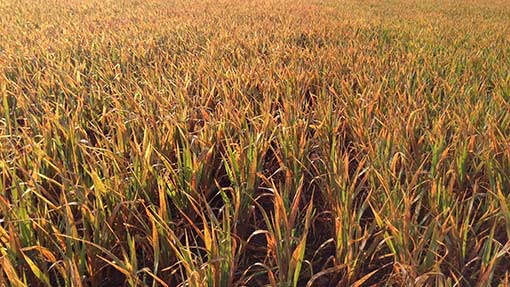Oats offer simple solution as valuable cover crop

Growing spring oats as a cover crop before vining peas is helping Lincolnshire farm manager Peter Cartwright improve yields by more than 1t/ha and build organic matter back into the soil.
Situated on the edge of the Lincolnshire Wolds, in Revesby, Mr Cartwright is bucking the trend of using costly cover crop mixes, which can cost more than £50/ha, by using a simple spring oat mix costing £15/ha.
“The benefit to the vining peas was incredible,” he explains. “We saw a big jump in yield in the areas where we had used a cover crop and visually a much healthier plant with stronger rooting systems and better soil structure.”
Read also: Cover crops may help against sugar beet pest
In a region of south Lincolnshire synonymous with vegetables and root crops, with the soils heavily worked, Mr Cartwright says he is keen to build up the fertility of his soils for the future.
Farm facts – Revesby Estate
Acreage 1,200ha (in-hand farm)
Cover crop mixes
- Spring oats
- Oil radish, bristle oat
- Berseem clover, phacelia, bristle oat
- Oil radish
- Phacelia
Cropping
- 490ha winter wheat
- 197ha oilseed rape
- 77ha sugar beat
- 150ha spring wheat
- 18ha spring beans (for the first time)
- 50ha vining peas
- 45ha maincrop potatoes
- 120ha permanent pasture
- Plus additional environmental areas
The managed area of the Revesby Estate ranges from low-lying fen land to higher land in the Wolds with a mix of soil types from heavy silts to lighter loams.
“There have typically been a lot of potatoes in the rotation and a lot of straw taken off the land, so there is a lack of organic matter and this is a perfect way to help restore that.
“It keeps the soils alive over winter, feeding all the bacteria and microbes. We’ve seen huge differences, not only in the yield, but also in the soil fertility.”
The oats were sown after a winter wheat crop on 20 September last year with a Vaderstad drill, before being sprayed off with glyphosate and ploughed back in the following spring, prior to the vining peas being drilled.
This season Mr Cartwright hopes to chop and mulch the cover crop into the soil with a Horsche Terrano to try to keep the organic matter in the top layer.
An area of cover crop was tried in front of sugar beet and this helped suppress weeds, so Mr Cartwright only needed to apply two herbicides rather than four in the beet crop.
This has convinced him to increase the area before sugar beet and vining peas and put some cover crops in front of spring beans, taking the total area of cover crops from 13ha to 77ha.
Improving soil fertility
Rooting is the key to success in any spring crop, according to Mr Cartwright, who says cover crops have helped roots thrive in the following crop.
He has seen a 14.3% increase in phosphite in the vining pea crop grown after a cover crop, which has been crucial in allowing each plant to scavenge for other nutrients.
He also saw a huge rise in manganese, with the plant tissue showing a nearly 40% increase.
“We suffer from a lack of manganese around here, so it has really proved important and a lot of it has got to be down to the improved rooting,” he says.
Blackgrass
Blackgrass control is a key priority on the estate, so cover crops are not grown in heavily-infested areas, but it does not rule out cover crops altogether.
Mr Cartwright has used the plough to bury as much blackgrass seed as possible and aims for multiple chits of the weed seed before drilling.
“We try to use the plough as little as we can, but it has done such a good job in reducing the blackgrass in some areas we’ve decided to plough the worse areas prior to a cover crop,” he says
The aim is to drill the majority of cover crops in late September, but this year the sowing will creep into October to trial how late the crop can be established.
The planned spring bean area is free of blackgrass and so will have a cover crop grown before it to build up fertility and prevent the soil slumping in the winter.
The plan is to spray the cover crop off with herbicide and then direct drill in the spring to allow for easy drilling and ensure the crop can get off to a good start.
The success with the oats has now spurred Mr Cartwright on to trial a wider range of mixes this year, including oil radish, phacelia, bristle oat and berseem clover.
“I’m hoping to prove we do not need to use expensive mixes, but I’m willing to try them,“ he says.
Greening requirements
Cover crops will become an important focal point in helping to meet the new Ecological Focus Areas (EFA) requirement as part of the CAP greening measures.
The three-crop rule is easily complied with at Revesby, but ensuring the EFAs are met has taken slightly more preparation.
This year, vining peas make up most of the EFA, meeting the nitrogen-fixing option, while 18ha of spring beans and one field of fallow have been added to make up the remaining area needed.
“Hopefully come this time next season, our cover crops will be sufficient to also meet the EFA requirements,” he says.
Mr Cartwright does point out that he might have to slightly adapt his cover crop mix to ensure in meets requirements.
“We may add a radish into the mix, which will add slightly to the cost, but we will also see benefits from it.

